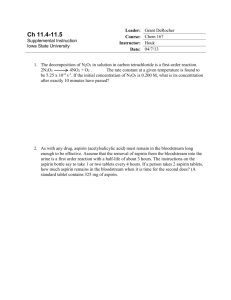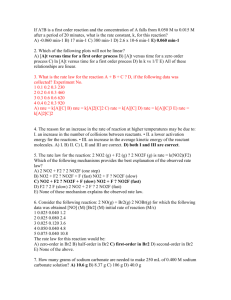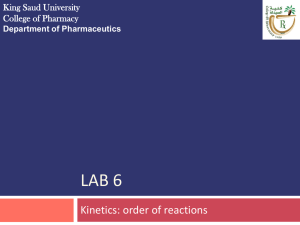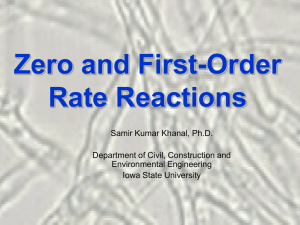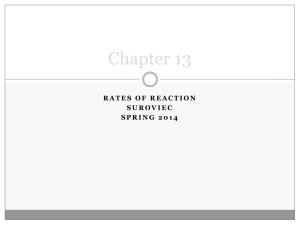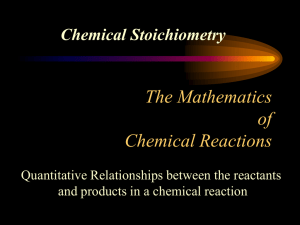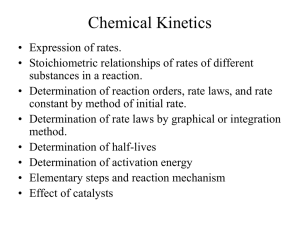Document
advertisement
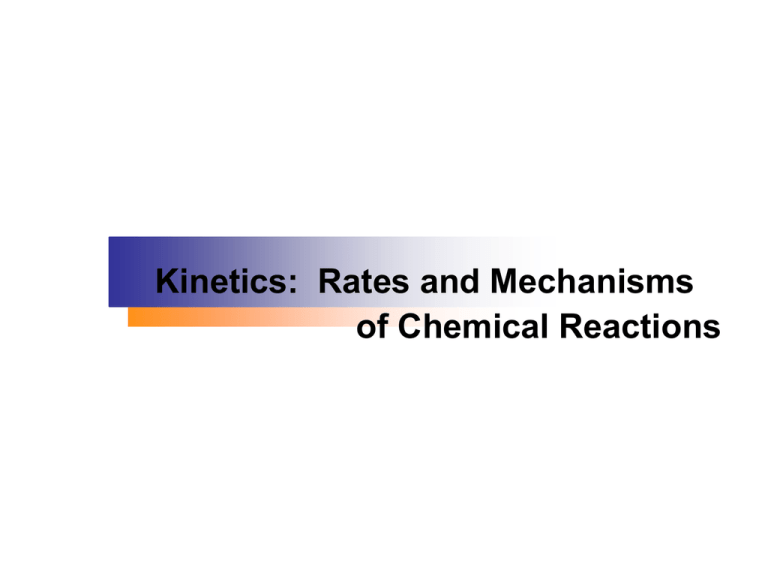
Kinetics: Rates and Mechanisms of Chemical Reactions Kinetics: Rates and Mechanisms of Chemical Reactions 1 Factors That Influence Reaction Rates 2 Expressing the Reaction Rate 3 The Rate Law and Its Components 4 Integrated Rate Laws: Concentration Changes over Time 5 Reaction Mechanisms: Steps in the Overall Reaction 6 Catalysis: Speeding Up a Chemical Reaction Chemical Kinetics Thermodynamics – does a reaction take place? Kinetics – how fast does a reaction proceed? Reaction rate is the change in the concentration of a reactant or a product with time (M/s). A B D[A] rate = Dt D[A] = change in concentration of A over time period Dt D[B] rate = Dt D[B] = change in concentration of B over time period Dt Because [A] decreases with time, D[A] is negative. 13.1 A B time D[A] rate = Dt D[B] rate = Dt 13.1 Problem PROBLEM: Expressing Rate in Terms of Changes in Concentration with Time Because it has a nonpolluting product (water vapor), hydrogen gas is used for fuel aboard the space shuttle and may be used by Earth-bound engines in the near future. 2H2(g) + O2(g) 2H2O(g) (a) Express the rate in terms of changes in [H2], [O2], and [H2O] with time. (b) When [O2] is decreasing at 0.23 mol/L*s, at what rate is [H2O] increasing? 2Br- (aq) + 2H+ (aq) + CO2 (g) Br2 (aq) + HCOOH (aq) time 393 nm light Detector 393 nm Br2 (aq) D[Br2] a DAbsorption 13.1 Br2 (aq) + HCOOH (aq) 2Br- (aq) + 2H+ (aq) + CO2 (g) slope of tangent slope of tangent slope of tangent [Br2]final – [Br2]initial D[Br2] average rate = =Dt tfinal - tinitial instantaneous rate = rate for specific instance in time 13.1 rate a [Br2] rate = k [Br2] rate = rate constant k= [Br2] = 3.50 x 10-3 s-1 13.1 Problem PROBLEM: Determining Reaction Order from Rate Laws For each of the following reactions, determine the reaction order with respect to each reactant and the overall order from the given rate law. (a) 2NO(g) + O2(g) (b) CH3CHO(g) 2NO2(g); rate = k[NO]2[O2] CH4(g) + CO(g); rate = k[CH3CHO]3/2 (c) H2O2(aq) + 3I-(aq) + 2H+(aq) I3-(aq) + 2H2O(l); rate = k[H2O2][I-] Measured Reaction Rates • The rate of reaction changes with time, as the concentrations of reactants and products change. • The rate constant, but not the rate, is independent of time. • The initial rate is the reaction rate measured before the initial concentrations have had time to change. Determining Reaction Orders • The rate law for a given reaction must be determined experimentally. This means determining the order with respect to each species involved. • The two major methods are – Initial Rate Method – Integrated Rate Law Method Initial Rates for a Series of Experiments in the Reaction Between O2 and NO Initial Reactant Concentrations (mol/L) Experiment O2 NO Initial Rate (mol/L*s) 1 1.10x10-2 1.30x10-2 3.21x10-3 2 2.20x10-2 1.30x10-2 6.40x10-3 3 1.10x10-2 2.60x10-2 12.8x10-3 4 3.30x10-2 1.30x10-2 9.60x10-3 5 1.10x10-2 3.90x10-2 28.8x10-3 Determining Reaction Orders Using Initial Rates Run a series of experiments, each of which starts with a different set of reactant concentrations, and from each obtain an initial rate. O2(g) + 2NO(g) rate = k [O2]m[NO]n 2NO2(g) Compare 2 experiments in which the concentration of one reactant varies and the concentration of the other reactant(s) remains constant. k [O2]2m[NO]2n rate2 = rate1 = k [O2]1m[NO]1n 6.40x10-3mol/L*s [O2]2m 2.20x10-2mol/L = 3.21x10-3mol/L*s = [O2]1m [O2]2 m [O2]1 m ; 2 = 2m 1.10x10-2mol/L Do a similar calculation for the other reactant(s). m=1 Problem PROBLEM: Determining Reaction Order from Initial Rate Data Many gaseous reactions occur in a car engine and exhaust system. One of these is NO2(g) + CO(g) NO(g) + CO2(g) rate = k[NO2]m[CO]n Use the following data to determine the individual and overall reaction orders. Experiment 1 Initial Rate(mol/L*s) Initial [NO2] (mol/L) Initial [CO] (mol/L) 0.10 0.40 0.10 2 0.0050 0.080 3 0.0050 0.10 0.20 0.10 Phosgene, a toxic gas is prepared by reacting carbon monoxide and chlorine gas. CO (g) + Cl2 (g) COCl2 (g) Experiment Initial [CO] Initial [Cl2] 1 1.00 0.100 1.29 x 10-29 2 0.100 0.100 1.33 x 10-30 3 0.100 1.00 1.30 x 10-29 4 0.100 0.0100 1.32 x 10-31 a) b) Initial Rate Write a rate law expression for this reaction Calculate the average value of the rate constant Units of the Rate Constant k for Several Overall Reaction Orders Overall Reaction Order Units of k (t in seconds) 0 mol/L*s (or mol L-1 s-1) 1 1/s (or s-1) 2 L/mol*s (or L mol -1 s-1) 3 L2 / mol2 *s (or L2 mol-2 s-1) First-Order Rate Law k A B R k[A] or d [A] kdt or [A] d [A] k[A] dt [A] t d [A] kdt [A] [ A ]0 0 [A] ln kt or [A] [A]0 e kt [A]0 First-Order Rate Law • Plot the experimental ln[A] vs. time • If the graph is linear, the reaction is first-order. • The slope of this line = -k ln [A] = - kt + ln [A]0 y = mx + b First-Order Processes Consider the process in which methyl isonitrile is converted to acetonitrile. CH3NC CH3CN How do we know this is a first order rxn? First-Order Processes CH3NC This data was collected for this reaction at 198.9°C. Does rate=k[CH3NC] for all time intervals? CH3CN First-Order Processes • When ln P is plotted as a function of time, a straight line results. – The process is first-order. – k is the negative slope: 5.1 10-5 s-1. First-Order Reactions The half-life, t½, is the time required for the concentration of a reactant to decrease to half of its initial concentration. t½ = t when [A] = [A]0/2 ln t½ = [A]0 [A]0/2 k ln2 0.693 = = k k What is the half-life of N2O5 if it decomposes with a rate constant of 5.7 x 10-4 s-1? 0.693 t½ = ln2 = = 1200 s = 20 minutes -4 -1 k 5.7 x 10 s How do you know decomposition is first order? units of k (s-1) 13.3 A plot of [N2O5] vs. time for three half-lives Second-Order Rate Law k 2A B R keff [A] 2 or d [A] keff dt or 2 [A] d [A] keff [A]2 dt [A] t d [A] keff dt 2 [A] [ A ]0 0 1 1 1 1 keff t or keff t [A] [A]0 [A] [A]0 Second-Order Rate Law • Plot the experimental 1/[A] vs. time • If the graph is linear, the reaction is second-order. • The rate constant is k = slope 1 1 kt [ A] [ A]0 y = mx + b Second-Order Half Life 1 1 kt1 2 [ A] 1 [ A]0 2 1 1 kt 1 1 2 [ A ] [ A]0 0 2 1 t1 2 k[ A]0 Zero-Order Reactions A product D[A] rate = Dt D[A] =k Dt rate = M/s k= 0 [A] [A] = [A]0 - kt [A] is the concentration of A at any time t [A]0 is the concentration of A at time t=0 t½ = t when [A] = [A]0/2 [A]0 t½ = 2k rate = k [A]0 = k Graphical determination of the reaction order for the decomposition of N2O5 Integrated rate law summary 1/[A]t = kt + 1/[A]0 ln[A]t = -kt + ln[A]0 [A]t = -kt + [A]0 Problem Determining Reaction Concentration at a Given Time PROBLEM: At 10000C, cyclobutane (C4H8) decomposes in a first-order reaction, with the very high rate constant of 87s-1, to two molecules of ethylene (C2H4). (a) If the initial C4H8 concentration is 2.00M, what is the concentration after 0.010 s? (b) What fraction of C4H8 has decomposed in this time? Problem PROBLEM: Determining the Half-Life of a First-Order Reaction Cyclopropane is the smallest cyclic hydrocarbon. Because its 600 bond angles allow poor orbital overlap, its bonds are weak. As a result, it is thermally unstable and rearranges to propene at 10000C via the following first-order reaction: CH2 D H3C CH CH2 (g) (g) H C CH 2 2 The rate constant is 9.2s-1, (a) What is the half-life of the reaction? (b) How long does it take for the concentration of cyclopropane to reach one-quarter of the initial value? An Overview of Zero-Order, First-Order, and Simple Second-Order Reactions Zero Order First Order Second Order Rate law rate = k rate = k [A] rate = k [A]2 Units for k mol/L*s 1/s L/mol*s Integrated rate law in straight-line form [A]t = -k t + [A]0 ln[A]t = -k t + ln[A]0 1/[A]t = k t + 1/[A]0 Plot for straight line [A]t vs. t ln[A]t vs. t 1/[A]t = t Slope, y-intercept -k, [A]0 -k, ln[A]0 k, 1/[A]0 Half-life [A]0/2k ln 2/k 1/k [A]0 Temperature and Rate • Generally, as temperature increases, so does the reaction rate. • This means that k is temperature dependent. The Collision Model • In a chemical reaction, bonds are broken and new bonds are formed. • Molecules can only react if they collide with each other. The Collision Model Furthermore, molecules must collide with the correct orientation and with enough energy to cause bond breakage and formation. The dependence of possible collisions on the product of reactant concentrations A B 4 collisions A B A Add another molecule of A B 6 collisions A B A Add another molecule of B A B A B A B Activation Energy • In other words, there is a minimum amount of energy required for reaction: the activation energy, Ea. • Just as a ball cannot get over a hill if it does not roll up the hill with enough energy, a reaction cannot occur unless the molecules possess sufficient energy to get over the activation energy barrier. The effect of temperature on the distribution of collision energies The Effect of Ea and T on the Fraction (f) of Collisions with Sufficient Energy to Allow Reaction Ea (kJ/mol) f (at T = 298 K) 50 1.70x10-9 75 7.03x10-14 100 2.90x10-18 T f (at Ea = 50 kJ/mol) 250C(298K) 1.70x10-9 350C(308K) 3.29x10-9 450C(318K) 6.12x10-9 An energy-level diagram of the fraction of collisions exceeding Ea. Reaction Coordinate Diagrams It is helpful to visualize energy changes throughout a process on a reaction coordinate diagram like this one for the rearrangement of methyl isonitrile. Reaction Coordinate Diagrams • It shows the energy of the reactants and products (and, therefore, DE). • The high point on the diagram is the transition state. • The species present at the transition state is called the activated complex. • The energy gap between the reactants and the activated complex is the activation energy barrier. Copyright © The McGraw-Hill Companies, Inc. Permission required for reproduction or display. Reaction energy diagrams and possible transition states Problem 7 PROBLEM: Drawing Reaction Energy Diagrams and Transition States A key reaction in the upper atmosphere is O3(g) + O(g) 2O2(g) The Ea(fwd) is 19 kJ, and the DHrxn for the reaction is -392 kJ. Draw a reaction energy diagram for this reaction, postulate a transition state, and calculate Ea(rev). Consider the relationships among the reactants, products and transition state. The reactants are at a higher energy level than the products and the transition state is slightly higher than the reactants. SOLUTION: Potential Energy PLAN: Ea= 19kJ O3+O transition state Ea(rev)= (392 + 19)kJ = DHrxn = -392kJ 411kJ 2O2 Reaction progress Maxwell–Boltzmann Distributions This fraction of molecules can be found through the expression: where R is the gas constant and T is the temperature in Kelvin . Arrhenius Equation Svante Arrhenius developed a mathematical relationship between k and Ea: where A is the frequency factor, a number that represents the likelihood that collisions would occur with the proper orientation for reaction. The Effect of Temperature on Reaction Rate The Arrhenius Equation k Ae Ea RT where k is the kinetic rate constant at T Ea is the activation energy R is the energy gas constant ln k = ln A - Ea/RT ln k2 k1 = - Ea R T is the Kelvin temperature A is the collision frequency factor 1 T2 1 T1 . Graphical determination of the activation energy ln k = -Ea/R (1/T) + ln A Problem PROBLEM: Determining the Energy of Activation The decomposition of hydrogen iodide, 2HI(g) H2(g) + I2(g) has rate constants of 9.51x10-9L/mol*s at 500. K and 1.10x10-5 L/mol*s at 600. K. Find Ea. Information sequence to determine the kinetic parameters of a reaction Series of plots of concentration vs. time Initial rates Determine slope of tangent at t0 for each plot Plots of concentration vs. time Reaction Rate constant orders (k) and actual Compare initial rate law rates when [A] Substitute initial rates, changes and [B] is orders, and concentrations Find k at held constant and into general rate law: varied T m n vice versa rate = k [A] [B] Integrated rate law (half-life, t1/2) Use direct, ln or inverse plot to find order Rate constant and reaction order Rearrange to linear form and graph Activation energy, Ea Find k at varied T MECHANISMS A Microscopic View of Reactions Mechanism: how reactants are converted to products at the molecular level. RATE LAW MECHANISM experiment theory Copyright © The McGraw-Hill Companies, Inc. Permission required for reproduction or display. Rate Laws for General Elementary Steps Elementary Step Molecularity Rate Law product Unimolecular Rate = k [A] 2A product Bimolecular Rate = k [A]2 A+B product Bimolecular Rate = k [A][B] 2A + B product Termolecular Rate = k [A]2[B] A Problem 8 PROBLEM: Determining Molecularity and Rate Laws for Elementary Steps (1) The following two reactions are proposed as elementary steps in the mechanism of an overall reaction: NO2Cl(g) NO2(g) + Cl (g) (2) NO2Cl(g) + Cl (g) NO2(g) + Cl2(g) (a) Write the overall balanced equation. (b) Determine the molecularity of each step. (c) Write the rate law for each step. The Rate-Determining Step of a Reaction Mechanism The overall rate of a reaction is related to the rate of the slowest, or rate-determining step. Correlating the Mechanism with the Rate Law The elementary steps must add up to the overall equation. The elementary steps must be physically reasonable. The mechanism must correlated with the rate law. Copyright © The McGraw-Hill Companies, Inc. Permission required for reproduction or display. Reaction energy diagram for the two-step NO2-F2 reaction Copyright © The McGraw-Hill Companies, Inc. Permission required for reproduction or display. Reaction energy diagram of a catalyzed and an uncatalyzed process The metal-catalyzed hydrogenation of ethylene H2C CH2 (g) + H2 (g) H3C CH3 (g) Catalytic Converters CO + Unburned Hydrocarbons + O2 2NO + 2NO2 catalytic converter catalytic converter CO2 + H2O 2N2 + 3O2 13.6 Enzyme Catalysis uncatalyzed enzyme catalyzed
